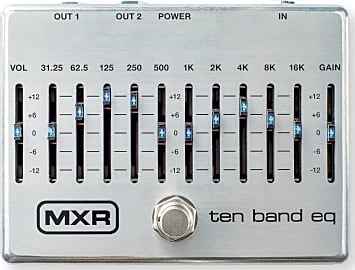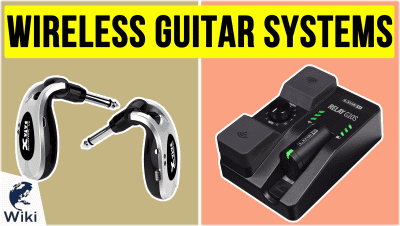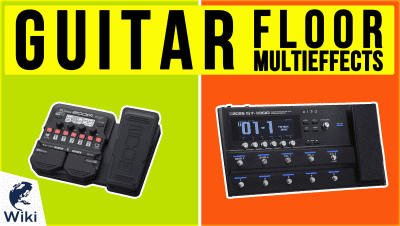The 10 Best Guitar Pedals

This wiki has been updated 34 times since it was first published in December of 2017. Very few guitarists simply play straight from their guitar to their amp. Even if you choose not to employ any effects, it's still a smart idea to invest in a good tuner pedal, but the odds are you're going to experiment with distortion or delay at some point. Whether you're new to effects or you're a seasoned box stomper, our list offers some of the best in the business. When users buy our independently chosen editorial selections, we may earn commissions to help fund the Wiki.
Editor's Notes
August 14, 2020:
The one big shakeup in this ranking was our decision to remove the Rat Pro Co Deucetone, which, like most offerings from the company, just couldn't overcome the compressed nature of its sound. I won't deny that some musicians, particularly in punk and emo genres might like it, but we wanted to make sure there was some versatility in our selection, with models that could effectively be used in a wide variety of styles. The Jim Dunlop Cry Baby Wah is perhaps an exception to this rule, as its sound is immediately recognizable and somewhat cliche at this point, but its connection to Hendrix and the history of guitar music entirely is too important to leave it off.
In place of the Rat we added the MXR M108S Ten Band, which has been a staple on my own board for years (though I have the Japanese import version with the LEDs that aren't obscenely bright, but that's only because it's all my guy had when I went looking for a graphic EQ). I find it particularly useful if you have a setup you really like with one guitar, but that needs some tweaking when you switch instruments. I leave it off, for example, when playing through my hollow-body Epiphone, but kick it on to boost the low end on my strat, which is naturally a bit thinner tonally.
The other addition to our list is in our special honors section, where you'll find the Minimooger MF Ring, which is a modernized version of an old Ring Modulator pedal by Moog. I had that original pedal, and this new model streamlined the output of old, providing a litany of sounds like a sweeping, otherworldly decay and distorted sub-octaves.
June 07, 2019:
So much of this kind of list comes down to taste and the needs of an individual sound, but there are some markers that can be used to evaluate quality from one pedal to the next despite this. The Electro-Harmonix Cathedral Reverb, for example, might not find its way into every guitarist's setup, but it offers so many tonal variations on the idea of reverb that it should be seriously considered by most players. Bypass fidelity is also a big issue among pedals, as they need to do little-to-nothing to alter a guitar's sound when inactive, and to preserve as much of the input tone as possible after they've applied their particular effect. While not an effect pedal, per se, the Polytune pedal at number four embodies this fidelity better than any other tuner on the market, and its ability to let you see the tuning of all six stings at once is fantastic. We did lose one of my personal favorite pedals to availability issues in the Moogerfooger Ring Modulator, but it was replaced by one of the more popular overdrive pedals out there: the Fullerton Full Drive 3.
Special Honors
Moog Minimooger MF Ring Musicians looking for something a bit unusual should check this model out, as it creates some very particular tones thanks to an analog circuit that can create anything from buzzy sound sweeps to dissonant pitch shifts. It's built like a tank, but it lacks some of the nuanced control offered by its predecessor, the original Ring Modulator. moogmusic.com
Creating Your Unique Sound
Most, if not all, created their signature sounds by employing at least one guitar pedal.
So, you saved up over a long time, and you finally got your hands on your dream guitar. Then, after another round of judicious saving, you were able to afford the amp you’ve always wanted. You set them up together and prepare to be blown away. And you know what? It sounds pretty good. But “pretty good” isn’t the stuff dreams are made of, nor does it elevate your playing anywhere above the thousands of other guitarists vying for attention in bars, in clubs, and online.
If you look back at the greats in guitar history — at least those who’ve relied on electric guitars to do their greatest work — you’ll find that very few of them simply plugged their axes into their amps and let fly whatever sound the combination offered. Most, if not all, created their signature sounds by employing at least one guitar pedal. Jimi Hendrix’s use of a wah pedal may be the only example you need to find proof of this.
For you to create a unique sound of your own, you will likely need to spend a long time experimenting with a variety of pedals. In my experience, after playing for more than 20 years, I’ve found certain brands I trust, as well as certain effects I cannot live without. On today’s market, it seems like there’s a new boutique pedal company popping up every few weeks, so you’ve got more variety at your fingertips than ever before. Fortunately, if you find a pedal that doesn’t quite blow you away, they tend to retain their value pretty well, so you can sell it off and reinvest in something new as needed.
The Most Essential Pedals
As you build out your pedal collection, there are a few cornerstones that you absolutely shouldn’t ignore. These are the pedals that most guitarists get their hands on, in one form or another, very early in the game. There’s a chance you may already own some of these if you’ve been playing for a while, but it may be time to upgrade those if you need, especially given how important these few pedals are.
First and foremost, your guitar can’t sound any good if it’s out of tune. A good tuner pedal should be the first thing in your setup, and it should be able to stop the signal from traveling to your amp as you tune, so your audience doesn’t have to hear you slowly tightening your strings.
After that, you’re going to want some kind of overdrive or distortion. Even if you play a predominantly clean sound, you can find an overdrive pedal that provides more warmth and texture than it does thrashing distortion. And, of course, there are plenty of pedals out there that can completely obscure your signal under layers of harsh fuzz.
After these two, you can and should invest in an equalizer pedal of some kind. These pedals, many of which feature graphic sliders, let you target and enhance specific frequencies coming from your guitar. These are particularly useful if you can’t quite afford the guitar or amp of your dreams, as they can help you mimic the frequency response of nicer equipment.
Other pedals worth seriously considering include delay, chorus, and reverb. Reverb will give you the ability to create realistic room performance, making your garage sound like anything from a dry studio to a soaking wet cathedral. Chorus adds a bit of wobble to your stereo sound, which is a great addition to clean guitar that won’t overdrive the tone. Delay creates a variety of feedback loops that you can use for texture and layering, creating mesmerizing soundscapes. One type of delay pedal, the loop pedal, actually allows you to record and layer short guitar lines, making it seem like there’s more than one player on stage.
There are more niche pedals on the market, like ring modulators and synthesizers, but these may not be the kinds of pedals you can employ very often. Still, if you hear something out there that intrigues you, you might find that one of these unusual pedals is just the thing to give you a sound unlike any other.
Other Great Guitar Accessories
Once you’ve begun to collect a few guitar pedals, you’ll find that lugging them around and powering them with a variety of adapters and daisy chains gets awfully annoying. The best way to handle this is to invest in a serious pedal board. Some guitarists like to build these, but the available versions on the market are pretty inexpensive considering how durable and reliable they are. Many are outfitted with mounting sections for power supplies that you can use to supply juice to your pedals without all those cumbersome adapters. A good pedal board will also have rows of Velcro stretched across it, which will allow you to reorganize your board whenever you need to, all while keeping your pedals firmly in place.
If you want to reduce your reliance on cords even further, you can invest in a good wireless guitar system. These radio-frequency-based systems instantly turn your guitar’s signal into a radio transmission that’s received by a supplied receiver and fed from there to your amp. As a result, they allow you to roam the stage with absolute freedom.
It’s also possible that all this talk of pedals has worn you out, and you’ve been using pedals and pedal boards for so long that you’re sick of it all. You might do well to invest in a multi-effects system, which houses an enormous amount of effects in a single interface. These can be particularly difficult to get started with, however, as their learning curve is far from steep. After enough time with them, however, they can turn out to be among your most useful tools.
As hard as it is to admit, sometimes your dream guitar doesn’t boast the best stock pickups. There’s no shame in swapping them out for a new set, and something warm and inviting like a stacked humbucker that can also rip through the roof as needed can be a smart and versatile investment.















